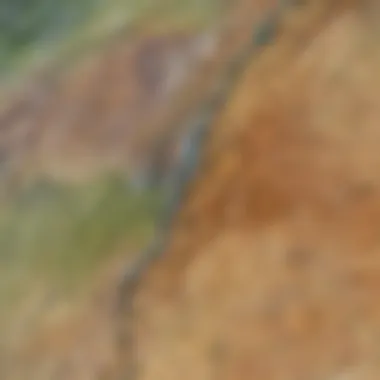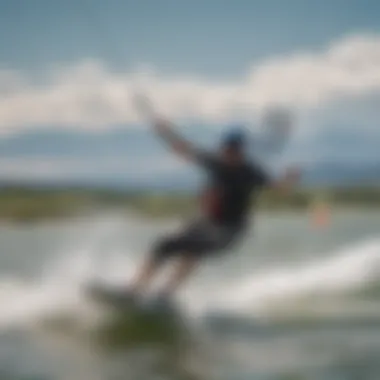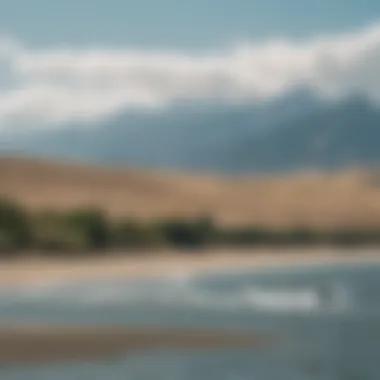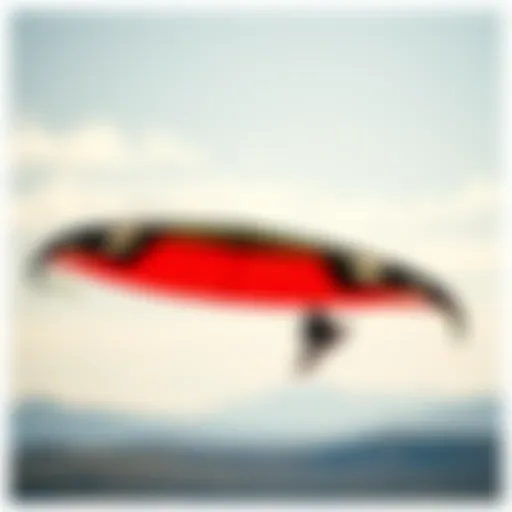Exploring Colorado's Wind Patterns for Kiteboarding


Intro
Kiteboarding is a thrilling sport, marrying the elements of wind, water, and skill in an exhilarating dance across the waves. Colorado, known for its breathtaking landscapes and diverse wind conditions, presents a unique playground for kiteboarders. However, unlocking the secrets of Colorado's wind speed can be tricky for even the seasoned riders. The intricacies of wind patterns are not merely trivial details; they serve as the backbone for a successful kiteboarding experience.
As any kiteboarder will tell you, understanding the winds can mean the difference between an unforgettable ride and a frustrating day on the water. This article dives deep into the dynamics of wind speed mapping in Colorado, shedding light on how these natural forces can enhance or dampen your kiteboarding adventures. Through a detailed examination of various wind data sources, we aim to provide you with not just technical information, but a guide to harnessing Colorado's windy blessings wisely and effectively.
In the following sections, we'll break down key techniques related to kiteboarding. We will consider both beginners who are just finding their feet — or, rather, their board — and advanced riders looking to push their limits with new maneuvers. Additionally, we will evaluate the latest gear and accessories that can significantly enhance performance on the water. By the end, you will not only be equipped with the knowledge of when and where to kiteboard in Colorado but also how to master the art itself.
Understanding Wind Speed Mapping
Wind speed mapping is a critical aspect of understanding the dynamics of kiteboarding, particularly in a location as diverse as Colorado. Kiteboarding, while thrilling, is also heavily influenced by wind patterns. This section will dissect the significance of wind speed mapping, shining a light on its definition, purpose, and how it pertains specifically to the kiteboarding community.
Definition and Purpose
At its core, wind speed mapping involves the graphical representation of wind speeds over specified areas, which are typically categorized by color gradients. This data is collected through various sources such as meteorological stations and satellite imaging. The primary aim of these maps is to convey information about wind conditions in an accessible format, allowing enthusiasts to make informed decisions when engaging in outdoor activities like kiteboarding.
Wind maps present real-time wind conditions and historical data, enabling users to analyze trends. This information plays a vital role in determining safe locations and optimal wind speeds for kiteboarding. Without accurate wind mapping, kiteboarders would be navigating blindly, exposing themselves to potential hazards.
Importance for Kiteboarding
For kiteboarders, understanding wind speed mapping can make the difference between an exhilarating adventure and a dangerous situation. The implications are broad, and here are a few key points to consider:
- Safety First: Kiteboarding in high winds can lead to accidents. Wind speed maps provide vital data to determine whether conditions are safe. Obeying the indicators on these maps can help prepar kiteboarders avoid risky situations.
- Optimal Conditions: Different kiteboarders have varying preferences for wind speeds based on their skill levels and equipment. Beginners might benefit from lower winds while seasoned professionals may seek stronger winds. By consulting wind speed maps, these preferences can be met more effectively.
- Routing and Locations: Colorado’s diverse geography presents unique wind patterns in different regions. Knowing where to find favorable winds can greatly enhance the kiteboarding experience. Areas like Cherry Creek Reservoir might offer consistent winds compared to other localities, identified through careful mapping.
Wind speed maps serve not just as a guide but as an integral part of the planning process for any kiteboarding outing. With this knowledge, kiteboarders can approach their sessions with confidence, making the most out of Colorado’s stunning landscapes and varied wind conditions.
"Wind maps are not just pictures; they're a kiteboarder's best friend! They turn uncertainty into clarity, guiding which way to ride the waves."
Understanding wind speed mapping is indispensable for kiteboarding enthusiasts looking to enjoy their sport safely and effectively.
Overview of Colorado's Geography
Understanding the geography of Colorado is crucial when looking into wind speed mapping, especially for kiteboarding. The state's unique physical features shape the wind patterns and their intensity, which kiteboarders must heed if they want a smooth and enjoyable experience on the water. When navigatin' the winds in Colorado, it's all about knowing what the land offers.
Elevation and Terrain
One of the key elements of Colorado's geography is its varied elevation, which creates a distinct wind dynamic across different regions. The Rocky Mountains dominate a significant part of the state; as this range rises sharply from the surrounding plains, wind behavior can drastically change. Generally, winds tend to pick up speed as they ascend the mountainous terrain. This phenomenon can lead to thrilling kiteboarding conditions, especially for those skilled enough to tackle the stronger gusts.
Moreover, the terrain includes not just mountains but also valleys and plateaus. Valleys can act like wind tunnels, channeling breezes and increasing their velocity. For instance, when winds descend from the mountains into a valley, they may accelerate, offering kiteboarders powerful updrafts. The varied landscape means that even a short distance can transition from mild winds to fierce gusts. That variability plays a major role in strategy for kiteboarding enthusiasts.
Maintaining awareness of how the elevation and terrain impact wind flow is essential. Kiteboarders should pay attention to potential obstacles such as hills or buildings that might interfere with wind currents. Winds can shift unexpectedly when they encounter such structures, and kiteboarders may find themselves dealing with unanticipated conditions.
Proximity to Water Bodies
Water bodies in Colorado also significantly influence wind patterns. Lakes, rivers, and reservoirs provide a picturesque backdrop for kiteboarding. Areas like Cherry Creek Reservoir or Horsetooth Reservoir often emerge as prime spots for kiteboarding, mostly due to their size and shape, which can encourage steady winds.
The proximity to water not only affects the wind speed but also the temperature and humidity. Water typically moderates temperature fluctuations, creating milder weather patterns, which is beneficial for kiteboarding. On sunny days, winds rising from the warm land can meet the cooler waters, generating veering breezes perfect for a day on the board.
Additionally, kiteboarders need to consider how the shape of a water body can impact wind conditions. For instance, a long and narrow reservoir may produce consistent crosswinds, while a larger, open lake might allow for more varied wind directions, fostering both challenge and excitement. People looking to kiteboard must scout locations to determine which water bodies align with their skill level and preferences.
In summary, grasping Colorado's geography is fundamental in understanding wind behavior, which ultimately dictates kiteboarding conditions. Elements such as elevation, terrain, and the strategic positioning of water bodies work hand in hand to create a dynamic environment ripe for kiteboarding adventures. As kiteboarders gear up for their next ride, keep these geographical influences in mind, for they can make all the difference on that water.
Seasonal Wind Patterns in Colorado
Understanding the seasonal wind patterns in Colorado is critical for kiteboarding enthusiasts as these patterns dictate both the intensity and direction of winds throughout the year. Kiteboarders must be aware of these changes to optimize their experiences on the water. By delving into the characteristics of each season, we can highlight how these dynamics play a vital role in determining the best times and locations for kiteboarding.
Winter Conditions
During the winter months, Colorado experiences a distinctive drop in temperatures, leading to unique wind patterns. In the high elevation areas, frigid air is common, resulting in less wind activity compared to other seasons. However, the valleys often see strong winds as cold air sinks, producing localized gusts.
- Benefits for Kiteboarders: Despite chilly temperatures, experienced kiteboarders may find some great opportunities if they dress appropriately. The strong gusts in the valleys can provide exhilarating conditions for advanced kiteboarding. Locations like the Eastern Plains can also create reliable wind patterns due to the plains' flat terrain.
- Considerations: Kiteboarders should take into account the potential for sudden weather changes. Blizzards and harsh winds can appear out of nowhere. Safety gear, as well as knowledge of local weather forecasts, becomes paramount during this season.
Spring and Summer Dynamics
As the snow begins to melt and temperatures rise, kiteboarding conditions transform dramatically. Spring introduces variable winds, where warm air mingles with cool mountain breezes. Summer, on the other hand, often features steadier breezes, especially during afternoons when thermal winds can pick up significantly.
- Optimal Locations: Cherry Creek Reservoir and Horsetooth Reservoir often become hotspots as the temperatures rise, attracting kiteboarders who seek those consistent afternoon winds. The geography of these areas contributes to a unique wind funneling effect, increasing the likelihood of enjoyable sessions.
- Pro Tips: Kiteboarders should keep an eye on local weather patterns and temperature fluctuations to plan their outings. Understanding the afternoon thermal winds, which generally occur due to differential heating, can greatly enhance the kiteboarding experience.
Fall Transitions
As summer fades, Colorado enters a transitional phase into fall where wind patterns can become unpredictable yet interesting. Cool fronts begin to dominate, leading to a mix of stronger gusts and lighter winds that vary from day to day.
- Kiteboarding Opportunities: Late summer and early fall can still offer excellent kiteboarding days, especially around Lake Granby. The natural beauty of fall combined with the thrill of kiteboarding makes it a favored time for many.
- Weather Awareness: During this time, it’s crucial for kiteboarders to remain vigilant about changing weather conditions. The interplay of warm and cold fronts can lead to sudden wind shifts, which, although can create thrilling moments, may also pose risks.


"Timing is everything when it comes to wind conditions. Knowledge of seasonal transitions not only aids in planning but enhances the overall kiteboarding adventure."
In summary, being aware of the seasonal wind patterns in Colorado allows kiteboarders to maximize their time on the water, making informed decisions about when and where to head out. Whether it’s the cold winter gusts, the lively spring and summer breezes, or the unpredictable fall winds, understanding these elements is vital to a successful kiteboarding experience.
Sources of Wind Data
When it comes to kiteboarding, the significance of wind data cannot be overstated. The ability to accurately assess wind conditions directly correlates to the safety and enjoyment of a kiteboarding excursion. Understanding where and how to gather reliable wind information is crucial for kiteboarders, instructors, and anyone involved in this exhilarating sport. In this section, we will delve into three major sources of wind data—meteorological stations, satellite imagery, and online wind maps—each offering distinct advantages and insights.
Meteorological Stations
Meteorological stations scattered throughout Colorado provide vital, real-time data on wind conditions. These stations are often situated in strategic locations like airports, research institutions, and open areas, designed to capture accurate weather patterns. The instruments they employ measure various parameters, such as wind speed, direction, and atmospheric pressure.
- Advantages: The advantage of meteorological stations lies in their precise measurements and historical data archives. For kiteboarders, this data aids in identifying trends over time, helping them select optimal periods for their activities.
- Considerations: However, it's worth noting that these stations might not represent localized wind conditions accurately. For instance, the wind behavior on a reservoir could differ drastically from what a nearby station reports. Hence, kiteboarders are encouraged to complement these readings with local observations.
"Understanding your environment is half the battle when it comes to kiteboarding. Relying solely on meteorological data without a sense of the local terrain can lead to misconceptions about wind potential."
Satellite Imagery
Satellite technology has advanced dramatically, making satellite imagery another critical source of wind data. By capturing large-scale atmospheric patterns, satellites provide kiteboarders with a broader view of wind trends over vast areas. This method allows enthusiasts to gauge wind intensity and movement across the entire state of Colorado.
- Benefits: Satellite imagery helps identify larger weather systems that influence local winds, from approaching fronts to changing pressure zones. Understanding these broader trends can give kiteboarders a tactical advantage when planning their sessions.
- Limitations: That said, satellite data often lacks the granularity found in meteorological stations. While it's excellent for spotting major shifts in wind patterns, smaller, localized gusts might go unnoticed. Thus, combining satellite insights with other data sources is advisable.
Online Wind Maps
In this digital age, online wind maps have become invaluable tools for kiteboarders. Websites and apps that provide interactive wind maps allow users to visualize wind speed and direction in real-time. These platforms often combine data from various sources, offering a comprehensive snapshot of conditions at specific locations.
- User-Friendly: These maps are not only user-friendly but can also be adjusted to reflect different times of the day or projections for the upcoming hours. This flexibility aids kiteboarders not just in planning their trips, but also in making real-time decisions while on the water.
- Caution: While online wind maps are incredibly useful, they are only as good as the data feeding into them. Users must ensure that the platform they are using is based on reliable data sources, whether that be meteorological stations or satellite input.
The interplay between these sources of wind data offers a robust framework for kiteboarders in Colorado. By tapping into real-time data from meteorological stations, leveraging the expansive insights provided by satellite imagery, and utilizing dynamic online wind maps, kiteboarders can enhance not only their safety but also their overall kiteboarding experience.
Reading the Wind Speed Map
Understanding how to read a wind speed map is key for kiteboarding in Colorado. With the state's varied geography and shifting weather systems, grasping the wind conditions is essential for both safety and maximizing enjoyment on the water.
Interpreting Color Gradients
The first thing that stands out on most wind speed maps is the use of color gradients. Each color indicates a different wind speed, making it crucial to familiarize yourself with what these colors represent.
- Blue shades typically signal lighter winds, ideal for beginners who are still learning the ropes.
- Green or yellow hues suggest moderate breezes, suitable for those looking to catch some air without the risk of being overpowered.
- Oranges and reds represent stronger winds, which can provide exhilarating rides but are more suited for experienced kiteboarders.
When viewing these gradients, consider the variability across the map. Some areas might show a deep red while others are light blue. This contrast highlights the importance of location—what might be optimal just a mile away could be challenging or unsafe.
"Understanding the map is like learning a new language; the more you practice, the better you’ll get at seeing the subtle nuances that can make or break your kiteboarding session."
Understanding Wind Direction Indicators
Wind direction is another vital element portrayed on wind speed maps. Indicators often appear as arrows or lines that show the wind’s origin. Knowing where the wind is coming from helps in planning your kiteboarding outing.
- North to South winds often provide a clean and direct path for kiteboarders on lakes situated in an east-west orientation.
- East and West winds can create more challenging conditions, especially if they blow across the water's surface.
It’s beneficial to align your kiteboarding plans with the wind’s direction. Setting up near an area where the wind blows directly onto the beach can give you a push, offering that extra lift to your jumps or glide.
Moreover, pay attention to how local geography, like hills or buildings, can influence these directions. A seemingly steady direction on the map might feel entirely different in reality due to these factors.
By taking note of both color gradients and wind direction indicators, kiteboarders can make informed decisions about when and where to ride, translating complex data into actionable insights.
Regional Wind Characteristics
Understanding the regional wind characteristics of Colorado is crucial for anyone involved in kiteboarding. This section dives into the unique dynamics that define the wind behavior across various parts of the state. Knowing how these characteristics play out can significantly influence a kiteboarder's experience, especially when selecting the best locations and times for their activities.
Eastern Plains Dynamics
The eastern portion of Colorado is marked by its flat landscape, which allows winds to flow freely across the plains. As air moves from the Rockies towards the east, it encounters less obstruction, resulting in sustained wind speeds. The high desert-like conditions often lead to stronger gusts during the spring and summer seasons.
Kiteboarders frequent locations like the Eastern Plains, taking advantage of conditions that can reach upwards of 20 mph on a good day. Factors such as local agriculture, with its various fields and irrigation systems, can create microclimates where winds might behave unexpectedly. It pays to keep an ear to the ground and talk to local kiteboarders about their experiences. They might let you in on little nuggets of wisdom that aren’t in any guidebooks.
Mountain and Foothill Influences
Move a bit west, and the terrain shifts dramatically with the foothills and mountains coming into play. Here, the wind dynamics change significantly due to elevation and geographical features. Winds can be interrupted and redirected by the mountains, leading to turbulence, downdrafts, and sudden shifts in wind direction, especially in the afternoons when thermal activities are at their peak.
Knowing this is indispensable for kiteboarders; it means always having a robust understanding of the specific wind conditions of the day. Here, seasoned kiteboarders often resort to weather station data and personal experience to gauge when and where to ride safely. Understanding thermals can mean the difference between a smooth ride and a chaotic session on the water.
Influence of Urban Areas
In urban settings, the wind behaves differently than in open spaces. Buildings and structures can create wind corridors or, conversely, shear winds, leading to unpredictable kiteboarding conditions. Urban areas like Denver, while not directly on water, can influence local wind patterns considerably.


Key Considerations for Kiteboarders in Urban Areas:
- Wind shadow effects: Tall buildings can cause significant downdrafts, which may catch an unsuspecting kiteboarder off guard.
- Breeze variations: Urban heat islands can enhance local breezes, changing speeds and directions quickly.
- Safety and regulations: Always be aware of local rules regarding kiteboarding in urban settings.
Overall, anyone serious about kiteboarding in Colorado should be equipped to handle the unique challenges posed by the region's varied wind characteristics. Whether it’s the expansive Eastern Plains, turbulent mountain areas, or urban landscapes, each setting brings its own influences that can greatly affect one’s kiteboarding experience. It's all about maximizing potential and mitigating risks.
Impact of Weather Systems
Understanding the impact of weather systems is vital for kiteboarders who crave not just adventure but safety and success when gliding across Colorado's waters. The interplay between various weather phenomena directly influences wind patterns, making it essential to grasp these dynamics for optimal kiteboarding experiences.
Fronts and Pressure Systems
Wind is heavily shaped by fronts and pressure systems that sweep through the region. In simple terms, a front is a boundary between two different air masses, and it often leads to a change in weather, including shifts in wind speed and direction. For kiteboarding, recognizing these fronts can mean the difference between a thrilling ride and a problematic one.
"When the warm air meets the cold air, that's where you'll likely see stronger winds."
- Cold Fronts: These fronts can bring strong, gusty winds as they push into an area. When a cold front approaches, the wind often shifts direction, which can create prime conditions for kiteboarding. However, these winds can also pick up quickly, catching inexperienced kiteboarders off guard.
- Warm Fronts: On the other side, warm fronts are generally associated with lighter winds initially. As the warm air rises, it creates less turbulent conditions, which can be favorable for beginners. Yet, this calm doesn't last forever; the instability that follows can lead to sudden weather changes.
Thunderstorm Activity
Thunderstorms are another key factor in Colorado’s wind conditions. While kiteboarding during a thunderstorm is a non-starter due to lightning risks, understanding how these storms develop can help kiteboarders avoid dangerous situations.
- Formation: Thunderstorms thrive in warm, moist environments. In Colorado, the Rocky Mountains elevate warm air that can collide with cooler wind, fostering storm development. This can lead to intense wind shifts and sudden gusts, which are not ideal for kiteboarding.
- Potential for Wind Shifts: As a storm approaches, kiteboarders may notice a noticeable drop in temperatures along with an uptick in wind speed—a classic hallmark of a brewing thunderstorm. Usually, the winds become erratic, toying with the idea of a calm day turned chaotic.
Kiteboarders should always check the radar for thunderstorm activity, as these storms can spring up unexpectedly and drastically alter wind conditions. Awareness of impending storms can ensure safety and prolong the thrill of kiteboarding under favorable conditions.
Case Studies of Popular Kiteboarding Locations
Understanding specific kiteboarding locations in Colorado is crucial for enthusiasts eager to elevate their experience with favorable wind conditions. These case studies offer real-world examples and insights that help kiteboarders make informed choices regarding where and when to practice their sport. By pinpointing local features, wind patterns, and logistical aspects, kiteboarders can optimize their adventures while navigating challenges unique to each site.
Cherry Creek Reservoir
Cherry Creek Reservoir stands out as one of Colorado’s most favored kiteboarding spots. This location is not just a water body; it’s a recreational hub catering to numerous outdoor activities, which makes it a lively place to kiteboard. The size of the reservoir provides plenty of open water, allowing kiteboarders to spread their wings without the worry of overcrowding.
Wind Conditions:
The wind at Cherry Creek tends to be relatively consistent, especially during the afternoon when thermic effects kick in. This is when the late summer heat starts heating the land, creating updrafts that can enhance wind speed considerably.
- Best Time to Go: Afternoon during the summer months—typically from May to September—seems most ideal.
Accessibility and Amenities:
Accessing the site is practical, with nearby facilities such as parking and restrooms. There are also lessons and rental equipment available for newcomers to the sport.
"Cherry Creek is more than a spot; it's where weekends come to life for many kiteboarders, turning the water into a vibrant playground."
Horsetooth Reservoir
Horsetooth Reservoir, nestled near Fort Collins, offers another prime kiteboarding destination marked by stunning scenery and diverse topography. The backdrop of the foothills provides not only a picturesque view but also varying wind patterns influenced by the mountainous terrain.
Wind Conditions:
The wind can be tricky here, as it often rolls down from the mountains in gusts that can be powerful. However, these gusts can also lead to exhilarating rides for seasoned kiteboarders. It's important to note that while this spot is exhilarating, it can be quite demanding for novices.
- Best Times to Ride: Spring and early fall ensure the wind is steady, before or after the summer storms typically seen during afternoons.
Considerations:
While the natural beauty is captivating, kiteboarders should remain alert. The varying terrain means wind conditions can shift quickly, emphasizing the importance of understanding local forecasts prior to setting off.
Lake Granby
Lake Granby, known for its expansive surface area and mountainous surroundings, is a beacon for kiteboarders eager for a more adventurous ride. This reservoir is the largest in Colorado and is an excellent choice for those looking to spend a whole day under the sun while flying their kites over expansive waters.
Wind Conditions:
The lake sees wind conditions that can vary significantly depending on the time of day and season. Early mornings might offer calmer winds which are good for practice, while afternoons can bring on stronger gales perfect for more advanced maneuvers.
- Ideal Riding Times: Typically, July and August provide the most consistent winds, making it a focus for kiteboarding activities.
Facilities and Community:
Lake Granby not only provides adequate facilities but also hosts a kiteboarding community. This sense of familiarity and inclusion can be vital for those starting out in the sport or those who wish to improve their skills in a supportive environment.
Forecasting Wind Conditions
Forecasting wind conditions is crucial for kiteboarding in Colorado, especially for those who want to maximize their experience on the water. Knowing when the wind will be favorable helps kiteboarders choose the right time and place, ultimately improving both safety and enjoyment. The ability to predict wind patterns effectively allows enthusiasts to plan their outings better and enhances their overall kiteboarding adventures.
Short-Term Forecasts
Short-term wind forecasts are particularly important for kiteboarders who want to seize the moment. These forecasts typically cover a timeframe from a few hours to a couple of days ahead. Accurate short-term predictions can mean the difference between an exhilarating ride and a frustrating afternoon.
Data from meteorological stations and online weather platforms allow kiteboarders to check the latest forecasts. Factors that contribute to short-term wind variations include:
- Local thermal effects, which can amplify winds in the afternoon.
- Variability due to passing weather fronts.
- Wind gusts that can change quickly, making it essential to stay updated.
Kiteboarders should look for specific tools like local weather apps, which provide real-time wind data, as these can be game-changers for immediate decisions. If you’re out at a spot and the wind shifts, the right application might just give you that insight you need to adjust swiftly.


Long-Term Patterns
Long-term wind patterns offer kiteboarders broader insights that extend weeks or even months into the future. This tactical understanding of potential wind trends fosters better planning regarding trips, equipment selection, and learning new skills during optimal conditions.
By examining historical data, kiteboarders can zero in on times of the year when conditions are generally more favorable. Some key aspects to consider include:
- Seasonality: Certain seasons bring predictable wind scenarios. Spring and summer often favor higher winds, making them ideal for kiteboarding.
- Weather Trends: Understanding the typical weather patterns in different regions of Colorado, like the plains versus mountainous areas, can help identify peak times for kiteboarding.
- Geographical Influences: Factors such as elevation and the presence of bodies of water can affect long-term wind behavior.
By noting these trends over time, kiteboarders can prepare for trips well in advance, select ideal locations like Cherry Creek Reservoir, and enhance their overall experience.
"The wind doesn't just blow; it carries dreams on every gust. Knowing when to ride the wave of the breeze is key to kiteboarding success."
In summary, understanding both short-term forecasts and long-term patterns is invaluable for kiteboarders in Colorado. These insights improve timing, safety, and enjoyment, making every ride a memorable experience.
Safety Considerations for Kiteboarding
Kiteboarding, while an exhilarating sport, is not without its hazards. Understanding the safety considerations associated with kiteboarding is crucial for both novices and experienced riders. Ignoring these factors can lead to accidents that may spoil a day out on the water or worse, specific injuries. As common as it is to hear about extreme conditions across various kiteboarding spots, the importance of safety cannot be overstated.
Understanding Risk Factors
Every kiteboarder should have a solid grasp of the risk factors involved in this sport. Several elements contribute to the overall safety landscape:
- Wind Conditions: High winds can increase the risks significantly. For instance, gusts over 30 mph might turn even a skilled kiteboarder's ride into a struggle. Checking those wind speed maps before heading out can mean the difference between an enjoyable day and trouble.
- Water Conditions: Pay attention to the body of water. Is it smooth or choppy? Are there any hidden obstacles beneath the surface? Understanding these features can help kiteboarders plan better for unexpected situations.
- Kite Size: The size of the kite in relation to the wind speed and rider weight can't be overlooked. A larger kite may catch too much wind, leading to loss of control.
"Careful planning can lessen risks and make all the difference in covering safe ground while kiteboarding."
Besides these, personal capabilities play a vital role. Visibility and weather changes can sneak up on you. If you're not confident about your abilities or are trying something new, it's wise to err on the side of caution.
Weather Awareness
In kiteboarding, having a keen sense of weather awareness is fundamental. This plays into safety, especially when navigating unpredictable scenarios. Here’s a few key points:
- Monitoring Local Forecasts: Local weather patterns can shift in a heartbeat. Keeping an eye on local forecasts, including rain, temperature, and wind changes, is crucial. Make sure to have reliable weather apps or websites in your toolkit.
- Understanding Local Patterns: Each kiteboarding location has its own quirks. Experienced kiteboarders can often predict conditions just by observing the clouds or wind shifts. Learn from locals and track their insights as these small tips can pay off much more than you’d think.
- Avoiding Thunderstorms: Storms can brew quickly, and kiteboarding during such conditions poses extreme dangers. Always heed warnings and stay out of the water if thunder rumblings are forecasted.
In summary, kiteboarding can offer an exceptional experience when enthusiasts embrace safety as a foundational aspect. By grasping risk factors and nurturing a habit of weather awareness, kiteboarders can maximize their enjoyment while minimizing danger.
The Role of Technology in Wind Analysis
The analysis of wind conditions has significantly evolved with the advent of technology. In the context of kiteboarding, this technological advancement provides kiteboarders with critical insights about wind patterns and speeds. Technologies like drones and advanced modeling software play essential roles in collecting and interpreting wind data, allowing enthusiasts and professionals alike to harness information that can enhance their kiteboarding experience.
Using technology, kiteboarders can make informed decisions about when and where to ride, ultimately enhancing safety and enjoyment in the sport. Understanding how these tools work and their implications can transform how a kiteboarder approaches their activities. Here are two of the most impactful technologies used in wind analysis today:
Use of Drones
Drones are revolutionizing how kiteboarding enthusiasts assess wind conditions. Equipped with high-tech sensors, these flying machines provide real-time data on current wind speeds and directions. They can capture visuals from various altitudes, enabling kiteboarders to understand the wind flow over different terrains—something that traditional methods lack.
- Real-Time Data Access: Drones can relay wind conditions instantly, allowing for quick adjustments to plans. If a location becomes less favorable due to changing winds, kiteboarders can easily shift to an optimal spot without delay.
- Complementary Visuals: These devices can also map out potential hazards in the environment, such as power lines or obstructions in water, which are crucial for a safe kiteboarding experience.
- User Customization: With the ability to set parameters, kiteboarders can customize their drone flights to investigate specific locations of interest or even to monitor conditions over time.
Using drones not only enhances safety but also opens new avenues for exploration and understanding of wind dynamics across Colorado.
Advanced Modelling Software
Advanced modeling software offers another layer of sophistication to wind analysis. The integration of this technology allows for a comprehensive simulation of wind patterns influenced by geographic features and weather systems.
- Predictive Capabilities: Such software can forecast wind speeds and directions based on historical data and meteorological variables. For kiteboarders, this means being able to predict favorable conditions days in advance, making trip planning far more efficient.
- Geospatial Analysis: These tools help overlay wind maps with geographic data, illustrating how local topography impacts wind flow. This intricacy allows kiteboarders to find less windy or gusty areas that are still enjoyable and safe for riding.
- Accessibility to Data: Modern modeling software is often user-friendly, enabling even beginners to visualize wind conditions without needing deep technical knowledge. This accessibility contributes to a better understanding of environmental factors that affect kiteboarding.
Incorporating advanced modeling into kiteboarding practices can lead to a marked improvement in skill development, safety, and enjoyment. The role technology plays in wind analysis not only enhances performance but also deepens appreciation for the intricate dance between the kite and the wind.
"Wind is what sets the kite free; understanding it is what keeps the kiteboarder safe."
Through the strategic use of drones and advanced modeling software, kiteboarders in Colorado can confidently embrace the elements, potentially redefining their experiences on the water.
Final Thoughts on Wind Mapping and Kiteboarding
Understanding the wind mapping in Colorado serves as an invaluable tool for kiteboarding enthusiasts, instructors, and marketers alike. The local topography, weather patterns, and seasonal changes significantly influence kiteboarding experiences, and with the right knowledge, one can make better-informed decisions about when and where to hit the water.
Summarizing Key Insights
In this article, we have explored the broad scope of Colorado's wind speed map and its implications for kiteboarding. Here are some of the critical insights:
- Geography Matters: The rugged terrain of Colorado, featuring mountains, valleys, and lakes, creates diverse wind conditions. From the Flatirons of Boulder to the expansive plains, every kiteboarding location offers unique challenges and advantages.
- Seasonal Variability: Wind patterns fluctuate throughout the year. Mastering these seasonal changes equips kiteboarders to choose prime months for better wind speeds.
- Data Sources: Effective wind mapping involves multiple data sources like meteorological stations and online wind maps. Understanding how to utilize these resources can enhance your kiteboarding experience and safety significantly.
- Localized Forecasting: Kiteboarders should pay special attention to short-term forecasts that predict wind conditions on a daily basis. Often, conditions can change rapidly, and a solid grasp of forecasting can mean the difference between a decent day on the water and an extraordinary one.
"Knowledge not only guides our journey but also shapes our experience. In kiteboarding, knowing the wind is like knowing the dance of the ocean, creating joy on the waves."
Future Trends in Wind Analysis
As we look ahead, several trends in wind analysis are worth noting. These innovations promise to refine how kiteboarders approach their sport:
- Advanced Data Analytics: With the rise of big data and machine learning, kiteboarders may soon have access to highly accurate predictive models tailored to specific locales.
- Mobile Applications: Expect to see more user-friendly apps designed specifically for kiteboarding conditions. Such tools will allow real-time updates on wind speed and direction, making it easier to monitor conditions while on the go.
- Community Engagement: Platforms like Reddit and specialized kiteboarding forums will continue to foster community discussions around local wind conditions, providing real-time feedback that enriches collective understanding.
- Environmental Monitoring: Growing concerns about climate change are leading to better wind pattern mapping concerning ecological impacts. Understanding these changes can foster responsible kiteboarding practices while ensuring the sport remains enjoyable for future generations.
As kiteboarding continues to gain popularity, the importance of understanding wind mapping cannot be overstressed. Acquiring knowledge in this area enhances the overall kiteboarding experience, ensuring safety while maximizing enjoyment on the water.







